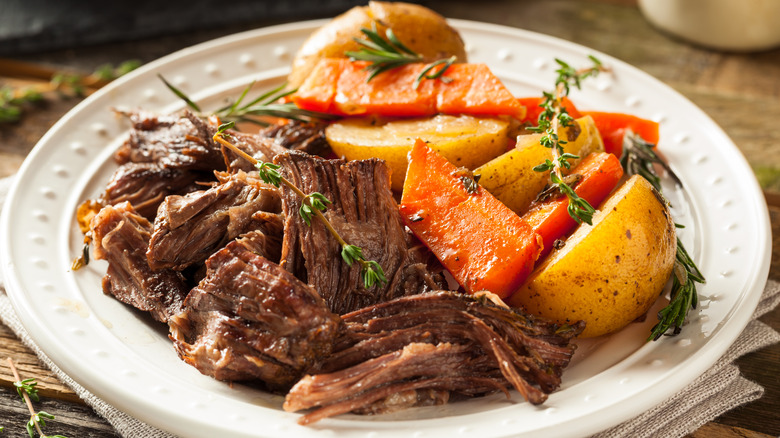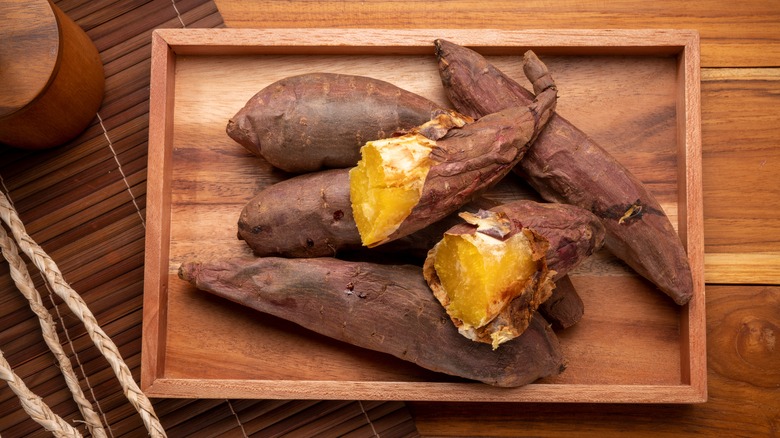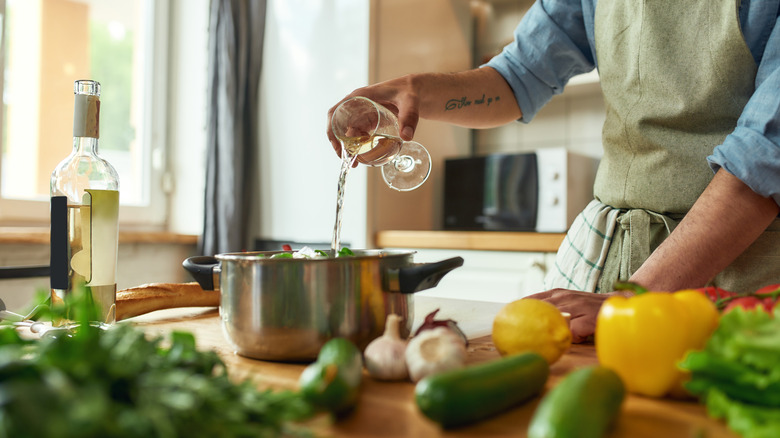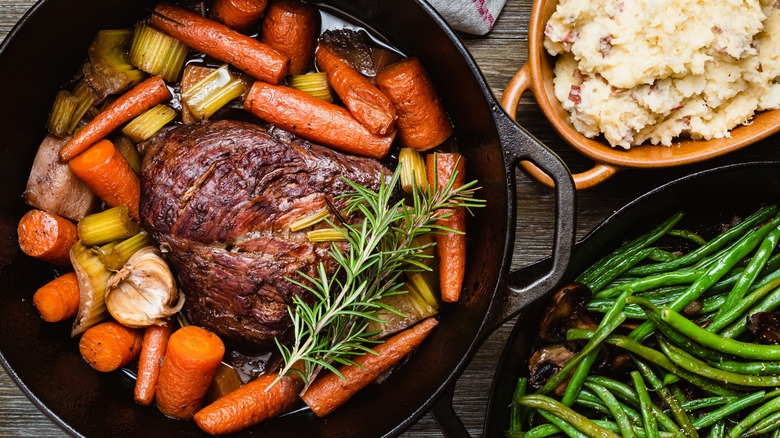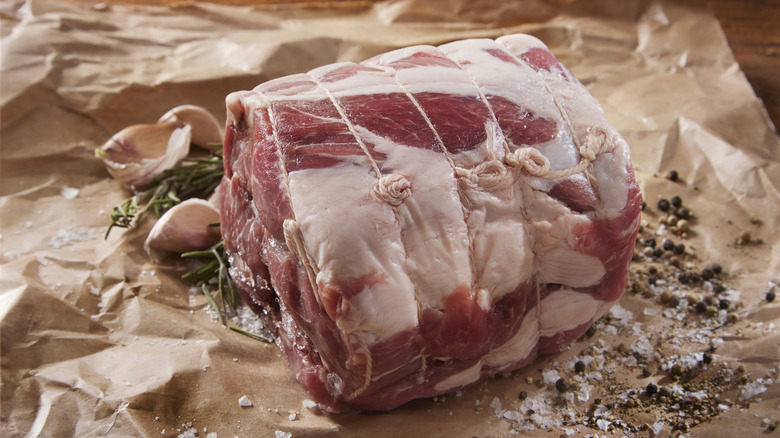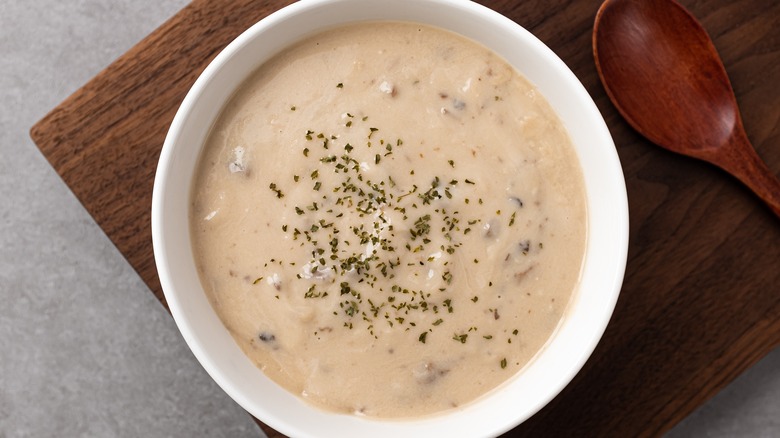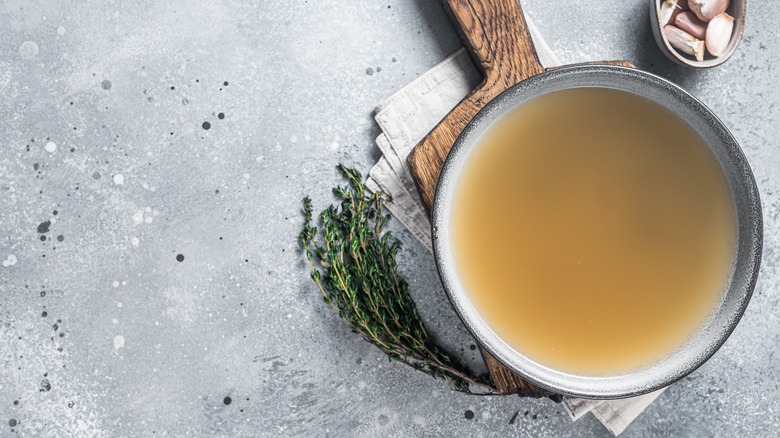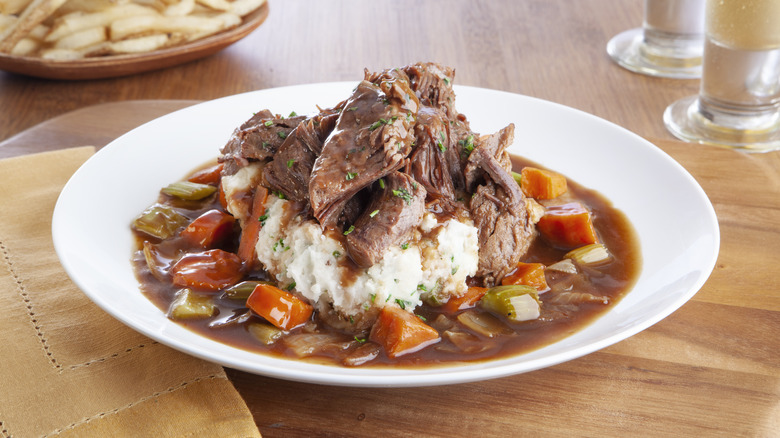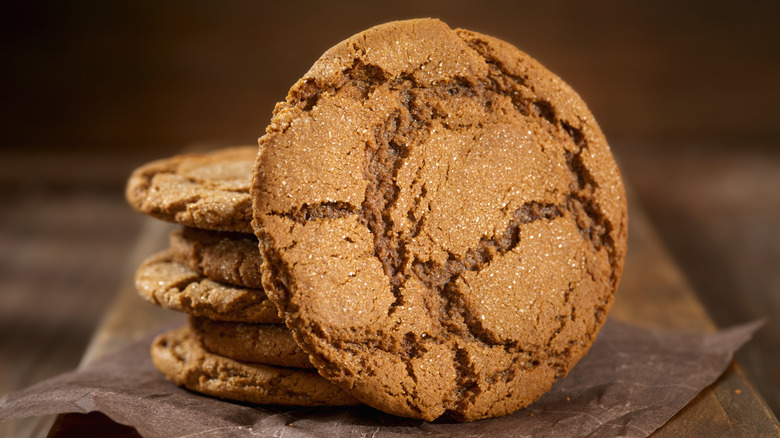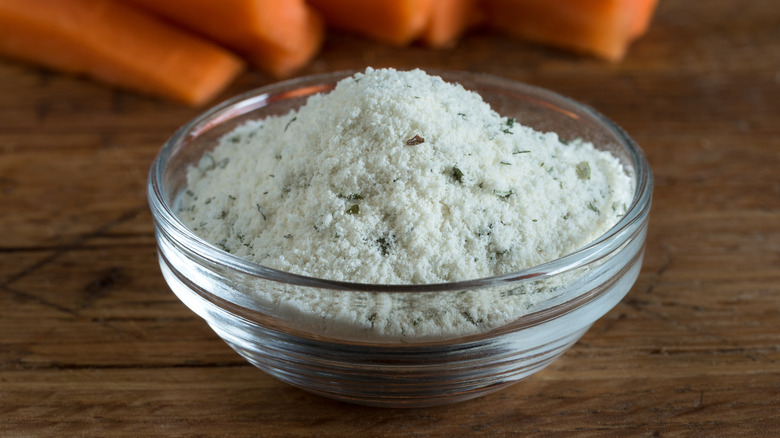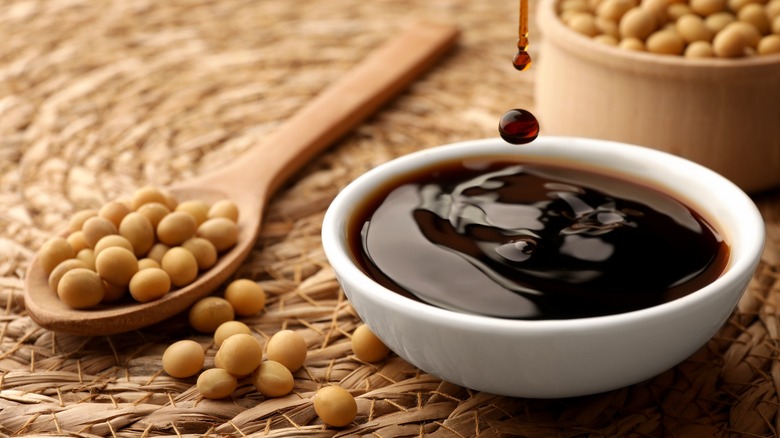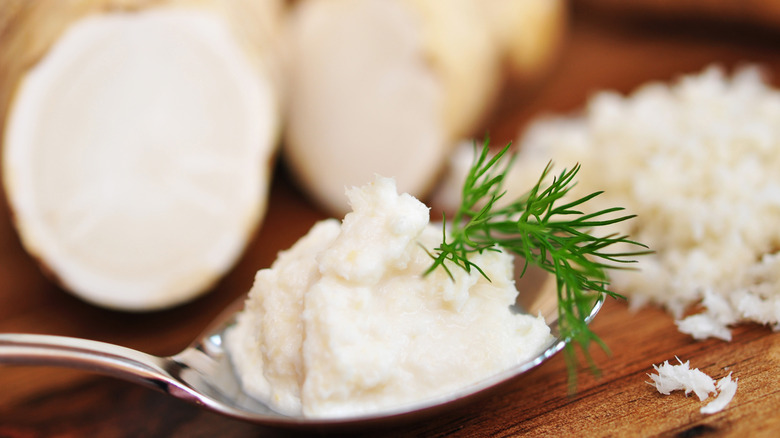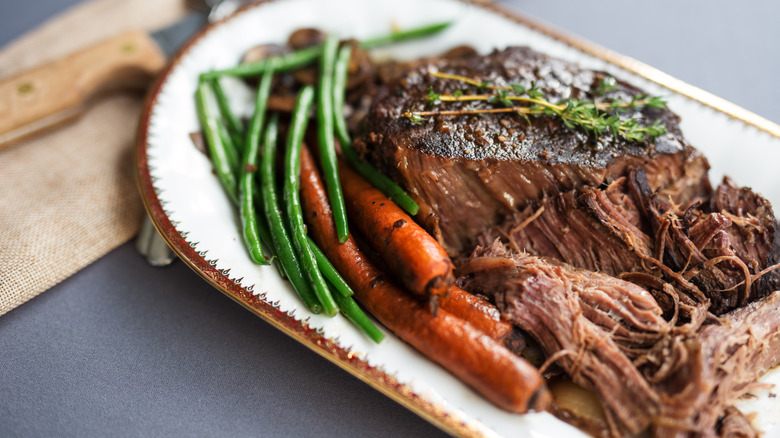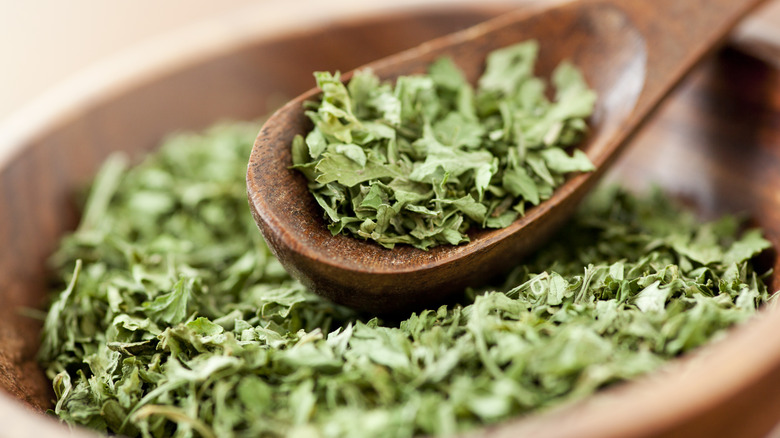14 Ingredient Swaps That Will Make Pot Roast So Much Better
What's more comforting than a pot roast? In our opinion, not much. This reliable meal harnesses the power of slow cooking to produce meat that's fork-tender, endlessly juicy, and contains massive amounts of flavor. One of the joys of a pot roast is its one-pot cooking style, allowing you to simmer your meat, carbs, and vegetables together. The flavors of all these different elements melding into one another makes for a dynamite dish.
Pot roast's predictability, however, is both its strength and its weakness. While almost everyone is familiar with how a Sunday beef pot roast is made, and what ingredients it uses — a substantial chunk of beef, carrots, onions, potatoes, beef stock, and a few seasonings — not many people realize that this dish can be tweaked in an almost endless number of ways. Nearly every one of these standard ingredients can be swapped out for something different, giving your weekend meal a fresh and exciting twist. Additionally, throwing in some extra elements can give it a whole new lease of life, and turn your reliable dinner into a real showstopper. These are the ingredient swaps that will make your pot roast so much better.
1. Use sweet potatoes for extra sweetness
Potatoes are an essential part of any pot roast. The main accompaniment to your meat, they provide the dish with a starchiness that helps mellow out the roast's flavor and thicken your gravy, as well as delivering the all-important carb content that makes pot roasts so satisfying. If you're getting a little bored of your regular potatoes, though, swapping them out for sweet potatoes can be a great alternative.
Using sweet potatoes instead of regular white ones gives your pot roast — what else? — added sweetness. But it also adds slight maltiness you wouldn't get otherwise. The bright orange tones of sweet potatoes also make your dish more colorful and aesthetically pleasing. Plus, when cooked, sweet potatoes turn soft and creamy, just like normal potatoes. This helps bulk out your beef broth.
Although sweet potatoes can sometimes cook faster than white potatoes, for a slow-cooked dish like a pot roast, there's no need to make any significant adjustments to timing or to add them in later. Just throw them in at the start with the rest of your ingredients and let everything cook together.
2. Instead of red wine, use white
Although red wine isn't a listed ingredient in every pot roast recipe, it certainly shows up in a lot of them, and for good reason. Red wine and beef are a killer combo; the layers of fruitiness in the former help to round out the latter. Simultaneously, the alcohol in the drink interlaces with the fat molecules in the meat and other elements of the dish, intensifying the overall flavor and heightening its pleasurable smell.
If you don't have any red wine at hand, however, you can use white wine instead. When incorporated into your pot roast's braising liquid, white wine gives your meat a certain lightness, as well as a crisp fruitiness that isn't quite as heavy as red wine. White wine also works very well with your vegetables, especially onions, and helps activate your herbs, giving everything a rich, complex aroma. The best type of white wine for cooking is normally a dry variety, but don't be afraid to pick a fuller-bodied one for a pot roast. You want your wine to be able to stand up to the rich flavor of your beef, so fruitier, bolder, sweeter wines work very well here.
3. No wine? Just use an easy substitute
If you don't have any wine in the house but your pot roast recipe is calling for some, it's easy to feel a little stuck. How do you add all of the extra flavor and moisture that wine provides? Luckily, help is at hand — and it's closer than you think. In a pinch, you can simply substitute some extra beef broth for the red wine in your recipe. It may not give the dish all of the depth that wine does, but it will give your beef extra savoriness.
If you want something a bit more creative, there are other substitutes you can try. Cranberry and pomegranate juice are both awesome choices that give your pot roast extra sweetness, as well as a slight acidity that helps balance out its savory flavor profile. They also add that all-important deep red color to the dish. These substitutes are a great choice if you're cooking for people who, for whatever reason, can't or don't wish to have alcohol in their food, or for kids who might find wine's flavors too complex. Just bear in mind that adding too much of any juice will make your food too sweet, so use them sparingly.
4. Swap beef with a different meat for new flavors
Pot roast is almost always made with beef — but that doesn't mean you can't mix things up now and again. In reality, any type of meat that can be roasted can be swapped for beef in your pot roast, and doing so can give you some beautiful results. If you want a slightly lighter dish that still has full-throttle flavor, use chicken thighs instead of chuck roast. The fat content of chicken thighs means they remain juicy and flavorful even when cooked for long stretches, but they have a slightly gentler flavor than beef.
Pork shoulder can also be a good choice that helps develop new textures in your pot roast. Cook your roast as normal until the pork meat is tender, then place your pot under the broiler for a few minutes before serving. This helps to crisp the thick layer of fat on top. If you want your pot roast to have an even deeper, gamier flavor, you can also use lamb. Like beef, lamb becomes super-tender when cooked for long periods, and its natural fats keep it from drying out.
5. Sub in mushroom soup for a creamy gravy
Your pot roast's gravy is key to its success, and if it doesn't thicken or have enough flavor, you'll end up disappointed. Subbing in cream of mushroom soup is a great way to prevent both of these things from happening. Cream of mushroom soup gives your pot roast an immediate pop on the flavor front; it adds creaminess and a savoriness, and boosts the dish's seasoning. Using this soup is also a good way to add body to your gravy, which is particularly useful if you're making a pot roast without potatoes — their starchiness provides bulk.
Cream of mushroom soup's flavor is also delicate enough to meld with all your other ingredients without becoming overpowering. It's also probably no shock whatsoever to learn that it goes well with the mushrooms in the meal. Bear in mind, though, that cooking with cream of mushroom soup can produce big mistakes, so you need to be smart about how you use it. The main thing we suggest is to use the best-quality cream of mushroom soup you can find. Your dish is only ever as good as your cheapest ingredient, and if you try and cut corners, you'll taste it pretty quickly.
6. Using vegetable stock instead of beef can lighten its flavor
Have you ever found that your pot roast is a bit too intense in flavor? If so, there's an easy swap you can make to immediately brighten it up. Skip the beef broth and use vegetable broth in equal amounts. Vegetable broth has a way lighter flavor than beef broth and isn't quite so heavy on the umami, being more herbal and crisp. It also prevents your pot roast from taking on any artificial beef flavors which can distract from the real thing. This can sometimes occur with lower-quality beef broths (although using a homemade beef stock can help counteract this).
If you don't have beef or vegetable broth, you can also use chicken broth, which is a middle ground between the two flavors. Chicken broth tends to pack a good punch of umami, but isn't quite as malty as beef broth can be. Finally, if you don't have beef broth but still want its intensity, a cup of light-brewed coffee can do the trick. Coffee adds the depth that beef broth delivers, as well as the dark brown color that neither chicken nor vegetable broth can create.
7. Swap your seasonings for onion soup mix
A pot roast requires a lot of ingredients. Many cupboard standbys like dried herbs, pepper, salt, and other spices make their way into the dish. However, if you're not in the mood to measure all of these out or you're missing a vital ingredient, help is at hand in the form of onion soup mix. Adding a sprinkle of onion soup mix is a great way to simplify your pot roast and add loads of flavor in one fell swoop. These mixtures pack a huge amount of onion taste into the meal and are frequently made with herbs and spices that add extra dimension.
Onion soup mix takes the hassle out of measuring salt quantities. And, because pre-made soup mixes often contain cornstarch, they also work as a thickener. Keep in mind that some store-bought onion soup mixes can be overly salty, though, so you should always add a little at a time, reserving some for once you've done a taste test. Don't forget, you can also always tweak your onion soup mix to add in any flavors you feel it's missing. If your mixture isn't herby enough for your liking, for example, try stirring in some extra oregano, thyme, or dried parsley.
8. Replace your aromatics with gingersnap cookies for a German twist
Beef and gingersnap cookies are probably not a combination you've tried — but once you do, we doubt you'll go back to your regular pot roast again. Gingersnaps are a key ingredient in sauerbraten, a traditional German dish made with marinated meat and cooked on the stove, just like a pot roast. Unlike pot roast, though, the meat for sauerbraten is marinated for several days before cooking, giving it huge flavor and serious tenderness.
In classic sauerbraten recipes, the gingersnap cookies take the place of traditional pot roast seasonings like dried herbs and garlic. They are simmered with the cooking liquid to make the gravy, which is then poured over the sliced meat. If you so desire, you can experiment with crumbling gingersnaps directly into your cooking pot, where they'll soften and thicken the gravy over time. It's useful to remember that gingersnap cookies are sweet as well as spicy, and being too heavy-handed will destroy the subtle piquancy they give your food. To prevent your pot roast from becoming too dessert-like, be sparing with your cookies, adding more if you need to at the end.
9. Make your roast extra creamy with ranch dressing mix
Creaminess isn't the desired effect with pot roasts, but you do want a certain smoothness and bulk to your gravy. One of the best ways to achieve this is to skip the cornstarch and instead add ranch dressing mix. This may be a surprising ingredient, but it makes a lot of sense when you think about it. Ranch dressing mix packs your pot roast with immediate flavor. The dried parsley, dill, and chives that make up so much of this seasoning blend give floral notes and lightness to your meat. Meanwhile, the dried buttermilk powder lends your pot roast dairy richness and a hint of sourness that works very well with the meat.
It's worth remembering that ranch seasoning won't make your pot roast taste like ranch dressing. Instead, it will simply boost its flavor and add mellowness and brightness. Just be careful about how much you add, especially if you're still using your regular seasonings. Ranch dressing mix is incredibly salty, and can quickly turn your pot roast into an unsalvageable mess with just a few too many dashes.
10. Instead of tomatoes and Worcestershire sauce, use booze
Plenty of pot roast recipes rely on two key ingredients to deliver massive flavor: tomatoes and Worcestershire sauce. Both foods are rich in umami, giving your pot roast an intense savoriness, and can be added with virtually no preparation, especially if you're using tomato paste or tomato sauce.
However, if you want to try something new with your pot roast, skip both of these additions and use booze instead, throwing a few shots of whiskey and a bottle of beer into the mix. The beer gives your pot roast and its gravy a maltiness and slight sourness. The whiskey, on the other hand, works wonders with your beef, amping up the oaky, smoky notes in the dish and providing further depth.
If you wish, you can also add these ingredients to pre-established pot roast recipes — but be careful. While whiskey and beer don't necessarily clash with the flavors of tomatoes and Worcestershire sauce, there's a risk of overpopulating your pot and producing a roast that's crammed full of flavor, without any balance or subtlety.
11. Use soy sauce instead of Worcestershire
Packed with anchovies, molasses, and tamarind extract, Worcestershire sauce is an intensely flavored marvel that adds punch to any dish. It's not to everyone's taste, though, and some folks just aren't a big fan of the tanginess and fishiness that it offers. So, if you want something a bit more simple but no less tasty for your pot roast, use soy sauce instead. Soy sauce gives much of the umami that Worcestershire does, as well as the deep brown color, but places its focus on saltiness and savoriness instead of sourness and slight funkiness.
Because soy sauce is so salty, though, you should watch how much you're using. If you add it alongside regular salt amounts, you can end up with a pot roast that's just plain briny. Both light and dark soy sauce work in a pot roast, with dark adding more smoothness and a deeper color. If you want to throw caution to the wind, you can also swap out your soy sauce for oyster sauce. Oyster sauce provides the same savory notes that soy and Worcestershire do, but it also adds sweetness and a slight fishiness that augment the roast's flavor in interesting ways.
12. For extra spice, coat your meat with horseradish
One thing that pot roasts don't tend to be is spicy; the dish instead banks on its satisfying savory flavors to deliver comfort and sustenance. While there's nothing wrong with that, tweaking your pot roast with a touch of fire can give it even more appeal. Adding some horseradish is a quick way to do so. Once you've browned your meat on all sides, coat it entirely with a jar of prepared horseradish, then cook it as normal. As it simmers away, the horseradish will gently permeate the outer layers of the meat, giving every bite extra spice.
Although a full jar of horseradish may sound like a lot, remember that it won't be that much per piece once you slice the meat. We would advise subbing the horseradish in for any other standard seasonings you use, like herbs and spices. Prepared horseradish's flavor is pretty punchy, so you don't want it competing too much with anything else. If you're especially worried about the heat it delivers, try and use the mildest variety you can, or simply use half the amount for a lighter coating.
13. Swap your seasonings with steak spice
If you want to simplify your pot roast seasoning, cover your meat in steak spice. Steak spice is the perfect seasoning blend to use for pot roast because it's designed to complement the natural flavors of beef, with each element helping to round out the meat's notes. The paprika, garlic, onion, and pepper in the mixture boosts the beef's savory elements, while the coriander and dill give it a vegetal counterpoint. The salt included in the spice mix ties everything together and intensifies the flavors, and the crushed red pepper adds a hint of spice.
Steak spice can also add a pleasant color to your pot roast; the paprika gives it a particularly striking maroon tone. As the steak spice also flavors your gravy, it fills every bite with deep, spicy warmth. If you want to amp it up an extra notch, try adding a layer of butter to your beef before you add your steak spice on top. This gives the meat and the seasoning blend much more richness, and adds a creamy undertone that stops the steak spice from tasting too harsh.
14. If your pot roast asks for fresh herbs, use dried ones instead
This simple substitute is also a real money-saver. If your pot roast calls for fresh herbs, you can skip buying pricey bushels that will sit and rot in the back of your fridge after you've used them once, and instead opt for the dried version. Dried herbs don't have quite the same taste as fresh ones; they tend to be more intense and lack certain kinds of piquancy. Some people like this more, some less. But you can be sure it'll save you money and time.
If you're using dried herbs instead of fresh ones, you'll need to adjust your quantities. It's best to use around a third of the listed amount — so, if your recipe calls for a tablespoon of the fresh stuff, use a teaspoon of its dried counterpart. You should also add your dried herbs at the start of your cooking process instead of at the end. Doing it too late will prevent their flavors from diffusing through your food properly.
